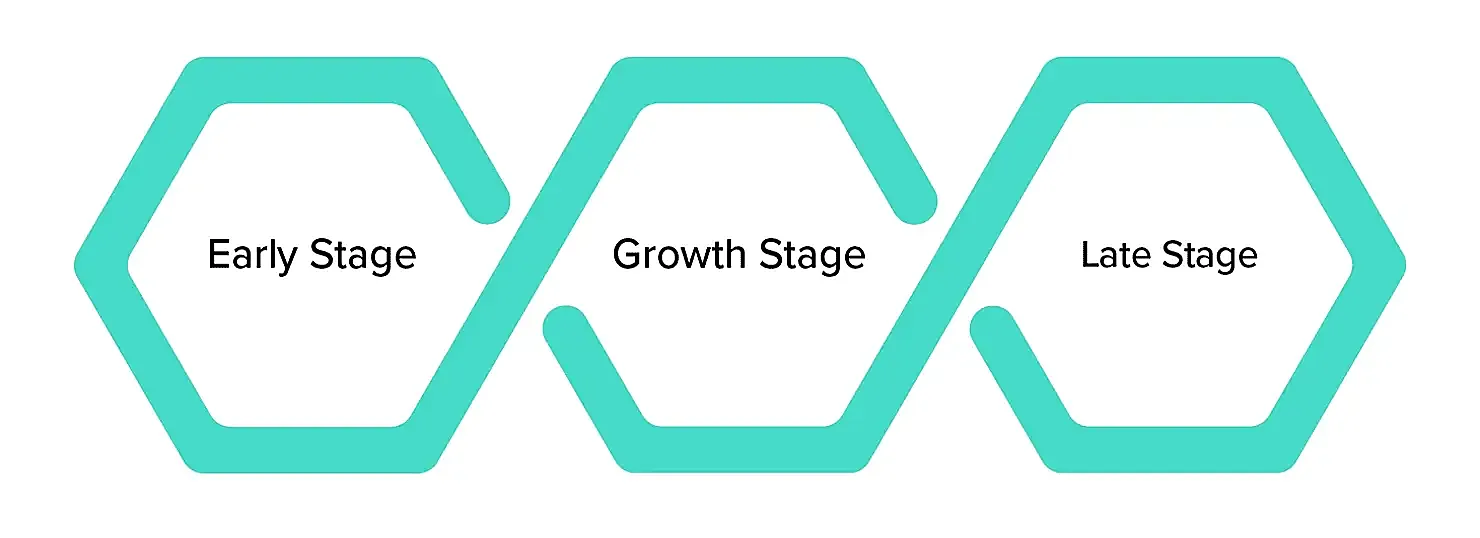
Startups were considered rare and risky up until a few decades ago. Complicated planning processes, large capital, and inadequate funding characterized them.
According to Forbes, a startup can grow into a larger organization by acquisition, building additional locations, sales growth above $20 million, or hiring more than 80 staff members.
The startup world has recently experienced a boom and has become renowned for its innovative products and services. Accessible technology and capital have led to a rise in emerging entrepreneurs.
Most startups, irrespective of the industry, primarily move through three stages. A thorough understanding of these stages of a startup can benefit entrepreneurs and investors. It will enable them to set manageable goals and chart their course better.
This blog explains the features of different startup stages and how they are funded.
What is a Startup?
A startup is a newly established business venture that is characterized by innovation, a focus on growth, and the pursuit of a unique business ideas. Unlike traditional businesses, startups typically operate in uncharted territory, often introducing disruptive products, services, or technologies to the market.
Startups are often founded by entrepreneurs or small teams with a vision to solve a specific problem or address a market gap. They are driven by a passion for their idea and a desire to create something new and impactful. Startups operate in a dynamic and fast-paced environment, where adaptability and agility are crucial for survival and success.
What Makes a Startup Successful?

The success of a startup relies on several factors, including excellent planning, hard work, and persistence.
Here are some key factors that determine the success of a startup:
Business Idea
A significant factor is a sound business idea. Founders tend to look for unsatisfied market needs, which they are uniquely positioned to resolve. The startups that address these real-world problems have a higher chance of success.
Product/Market Fit
The success of a startup also depends on whether the product or service meets the demands of the market and resonates with customers. To achieve product/market fit, entrepreneurs usually look for customer needs and ensure a strong demand for the product or service.
Team
The kind of team that works on the product can mean the difference between success and failure. A team of people with a good work ethic, ambitions that align with the company’s, and strengths that complement each other's can make a good idea even better. On the other hand, a lousy team can squander an excellent idea.
It is also essential that all members of the team understand their roles and responsibilities.
Timing
Timing is crucial. Rolling out the right product at the right time can boost startups to success. Startups must consider if the market, technology, and customers are ready for their solution.
The Three Stages of a Startup

The life cycle of a startup can be broken down into three broad stages. However, the evolution of a startup is a continuous process, and the distinctions between each stage in startup are blurry. Furthermore, not every brand will pass through every stages of a startup.
The duration of each stage is also highly variable. While one startup might spend years in a single stage, another might get through it in a few months. It depends on various factors, including the market, government policies, economic climate, and industry.
Here are the three major stages of a startup:
Early Stage
In this phase, the founders develop their ideas and outline their business plans. This stage is also described by various terms, including seed stage startup, pre-seed, post-seed, pre-A, and seed extension.
At this stage, the founders identify their target customer segment, analyze their problems, and articulate solutions. This could require multiple brainstorming sessions where ideas are proposed and refined.
Entrepreneurs must also conduct comprehensive market research at this stage in startup. This is crucial because it lets them determine the market opportunities around the challenge they are trying to resolve.
Further, once they come up with a solution, it must be compared with the other solutions available in the market. In other words, they must be aware of competitors and their products and make a brand strategy for startups.
Following that, they must ensure that their solution is different or better than the competitors’. Moreover, the resources required to introduce the minimum viable product (MVP) to the market must be calculated.
Other key characteristics of this stage include:
Funding
Friends, family, and crowdfunding typically fund startups at the early stage. This round is commonly known as bootstrapping. It might force entrepreneurs to prioritize the most essential aspects of the business.
Other forms of startup funding include angel and venture capitalists. Fundraising is usually slow as there is a lot of risk associated with investing at this stage.
Startups can also consider accelerator programs. Also known as seed accelerators, these programs provide guidance and support through mentors in exchange for equity in the business. They also provide limited funding.
These programs are instrumental in enabling startups to scale quickly. Most accelerators require companies to have made substantial progress in their product development.
As this stage comes before the Series A funding round, the startup must prove its potential to secure further funding. This is the stage where the company demonstrates its product market viability, competitive ability, scalability, and customer base.
Defining the Vision
This is also the stage where the founders determine the vision and mission of the company. They also define their goals and objectives for the next 12-24 months. The path to achieving these goals would dictate the business plan. The business plan must contain the structure and growth of the startup.
Most importantly, a mechanism must be devised to measure if the goals have been reached and the vision has been realized. The success of the company must be measured regularly through several metrics, such as customer acquisition cost (CAC), user engagement, and conversion rates.
Building a Team
The core team might not be fully defined or formed in the early stage. However, this vague team structure must be developed to create a cohesive and functional unit. The assembled team must share the company’s values and beliefs.
The roles of the co-founders must be clearly defined. There can also be advisors who can help further the company's interests through regular meetings.
Growth Stage
This is the stage of startup growth, where the company begins to execute its strategies, scale its operations, and create a presence in the market. It has withstood the difficulties of the early startup growth stages and finally started realizing its potential. The startup secures funding by demonstrating its ability to execute its business plan, acquire customers, and improve its functioning.
The startup typically begins to acquire recurrent customers and grow revenue during this stage. It also starts recruiting more employees and developing teams. This enables the startup to enhance its performance.
Important markers of the startup growth stages include:
Series A Funding
This is one of the most defining characteristics of this stage. Startups receive their first Series A funding rounds. Each round is generally an 18–24-month period. The first round of funding is more important than the successive ones.
Investing at this stage is not as risky as investing in the early stage. At this point, the company would already have shown signs of scaling. It would have a working product, paying customers, fast and efficient sales cycles, and product return on investment (ROI).
This capital allows the company to establish a solid foundation and strengthen its operations. However, it must also deal with the expectation of delivering substantial returns and startup lifecycle.
Venture debt is another option for high-growth companies with venture capital backing in the early stage. This form of startup funding offers more flexibility than other types of loans. The interest rates are usually higher, and the terms are shorter. Moreover, venture debt does not transfer control to new equity holders.
Venture capital companies often provide guidance and support to assist the startup in its growth journey.
Improving Operations
With increased funding, startups begin scaling their operations. They invest in technology and infrastructure to support their growth and development. This can include improvements in manufacturing, service delivery, or software development.
They can also hire more talent, which allows the founders to delegate responsibilities. This distribution of tasks to specialized experts allows them to contribute to and improve other important aspects of the company. For instance, a sales and marketing team can take up the task of acquiring and retaining customers.
This is one of the startup growth stages that also involves refining the product. Overall, the business becomes stable and sustainable at the growth stage startup.
It is important to remember that scaling operations can be uncertain. Founders must be willing to adapt to changing circumstances and prepared to handle scenarios where things don’t go according to plan.
Late Stage
Startups in the late stage have matured into an established company. They have successfully navigated the challenges of the earlier startup lifecycle stages and have built up considerable revenue. They might have a Chief Executive Officer (CEO) and other staff to look after engineering, marketing, sales, deployment, support, and other demands of a fast-developing business.
At this stage in startup, it is no longer the potential that defines the startup but its performance. The company's focus shifts to market growth and dominance, expanding the customer base, long-term sustainability with startup lifecycle, and even an exit strategy.
The primary concerns of startups at this stage include further growth, securing funds, and preparing the company for an Initial Public Offering (IPO) or a sale.
Here are some defining aspects of this stage:
Funding
Startups at this stage typically have steady funding. This may include funding from private equity firms, corporate investors, venture capital firms, and growth firms. Investors tend to require specifics, including current performance and projected success of the company.
Hence, keeping track of financial analytics and metrics is advisable. Acquisition, conversion, and engagement are some metrics to keep track of.
Mergers and Acquisitions
Startups can attain further growth through mergers and acquisitions. Acquiring smaller businesses, such as competitors or startups offering specialized products and services, can diversify the company’s operations. It brings a new dimension to its offerings.
Mergers and strategic partnerships allow startups to strengthen their position in the market. Collaborations can involve joint ventures and alliances with complementary businesses. This leads to the consolidation of resources and expertise.
Expansion
Expansion involves moving into new market segments that were not part of, but still adjacent to, their primary market. This often means diversifying the startup's products and services and adding to the product line. It can also entail opening up new offices.
Some startups may opt for global expansion after establishing themselves in the domestic market. This involves complying with international regulations and modifying products to suit diverse environments. Hence, successful global expansion requires an in-depth understanding of various markets, early stage startups, and adequate planning.
However, before expanding business, startups must assess their capabilities and determine if they can sustain the expansion. It might require additional fundraising or mergers.
Exit
Many founders and investors consider an exit at this stage. A solid exit strategy would involve increasing the valuation of the startup and making it an attractive target for an acquisition.
Favorable exits can be of two types – acquisition and Initial Public Offering (IPO). The startup is purchased by a larger corporation in an acquisition, providing founders and investors with a lucrative exit. It becomes a legal part of the purchasing company, along with all its assets and intellectual property.
Other startups may opt for an IPO, which is when a company goes public by selling its stocks to the general public. Earlier, when the company was private, only certain people could own stocks. However, after an IPO, anyone can buy stocks in the startup.
The sale price in the case of an acquisition and the stock price per share in the case of an IPO are both determined by the startup's valuation. The valuation, in turn, generally depends on revenue and stages of startup growth.
Wrapping Up
Entrepreneurship consists of going through various stages of startup growth. Each of these startup growth stages presents unique growth opportunities. Making use of these opportunities while also navigating challenges will lead to success.
Both entrepreneurs and investors must understand the specifics of each of the startup growth stages to be able to succeed in the world of business.
Frequently Asked Questions
-
What are the main startup growth stages?
-
What metrics are important to consider at each stage of startup growth?
-
What defines a seed stage startup?
-
What are the typical sources of funding for a seed stage startup?
-
How do early stage startups attract investors?
-
What challenges do growth stage startups face?
-
How do late stage startups differ from earlier stages in terms of operations?




















